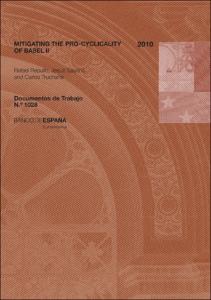Mitigating the pro-cyclicality of Basel II
Autor
Fecha de publicación
25-oct-2010
Descripción física
43 p. : gráf.
Resumen
Policy discussions on the recent financial crisis feature widespread calls to address the pro-cyclicaleffects of regulation. The main concern is that the new risk-sensitive bank capital regulation (Basel II) may amplify business cycle fluctuations. This paper compares the leading alternative procedures that have been proposed to mitigate this problem. We estimate a model of the probabilities of default (PDs) of Spanish firms during the period 1987 2008, and use the estimated PDs to compute the corresponding series of Basel II capital requirements per unit of loans. These requirements move significantly along the business cycle, ranging from 7.6% (in 2006) to 11.9% (in 1993). The comparison of the different procedures is based on the criterion of minimizing the root mean square deviations of each adjusted series with respect to the Hodrick-Prescott trend of the original series. The results show that the best procedures are either to smooth the input of the Basel II formula by using through the cycle PDs or to smooth the output with a multiplier based on GDP growth. Our discussion concludes that the latter is better in terms of simplicity, transparency, and consistency with banks’ risk pricing and risk management systems. For the portfolio of Spanish commercial and industrial loans and a 45% loss given default (LGD), the multiplier would amount to a 6.5% surcharge for each standard deviation in GDP growth. The surcharge would be significantly higher with cyclically-varying LGDs
Publicado en
Documentos de Trabajo / Banco de España, 1028
Materias
Bank capital regulation; Basel II; Pro-cyclicality; Business cycles; Credit crunch; Fluctuaciones y ciclos económicos; Regulación y supervisión de instituciones financieras
Aparece en las colecciones:












